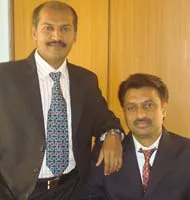Sanjay Borkar, CEO & Co-founder, Shivrai Technologies
Thursday January 06, 2011 , 8 min Read

“The idea of using software for farming continues to be a concept. We’re trying to change that with FarmERP.”
It’s almost utopian, isn’t it? The idea of farmers using software to optimize production and indulging in sustainable agricultural practices is something that has been spoken about in the past. But making that dream a reality is Shivrai Technologies, a Pune-based startup founded by entrepreneurs Sanjay Borkar and Santosh Shinde. Recently, we spoke to Sanjay about Shivrai Technologies’ journey so far and FarmERP, their flagship product.
Sanjay, give us a brief description about Shivrai Technologies.
Well, we are a software and mobile application development firm, functioning in the specialized domain of agro-business and agricultural research. We do some consulting and offshore development as well. But over the last 10 years, the focus has been on agriculture. We have products (software, mobile apps) for everyone in the value chain, ranging from farmers, farmer associations and agro-business companies to agricultural universities and research institutes.
Agriculture is not a space that technology entrepreneurs generally look at. How did you get into it?
Santosh (the co-founder) and I passed out of the University of Pune with degrees in Computer Science. This was in 1996. Right from the beginning, we always wanted to start something on our own and be entrepreneurs. Both of us were from agricultural families and we really wanted to serve that sector. But back then, IT and agriculture had no connection whatsoever. Even today, it’s at a very nascent stage. So, you can imagine how tough it would have been back then.
While we knew we wanted to serve farmers, we didn’t know how. So, till 1998, we took on software and multimedia projects to survive as a startup. This proved to be fruitful as our entry into the domain of agriculture started out with a multimedia project meant for farmers that we did for the Department of Agriculture, Maharashtra.
This was a brilliant opportunity. We got interact extensively with all the stakeholders in the agricultural community. We learnt about issues first-hand, rather than reading or hearing about it.
So, how did this experience change or alter plans?

Well, we had a clearer picture post this project. After much thought and planning, the business idea began to take shape in 2000-2001. We realised that farming is probably the only business activity where the person responsible for the business (the farmer) doesn’t have a clue about how much he’s going to end up with. Farmers seldom knew how much profit or loss they were likely to make. Traditional farmers didn’t have any projections or business calculations. They just went with the flow. We realised that software could be used for efficient farm management and lead to massive savings, in terms of time, resources and money. We could also use software to bring about the use of scientific methods and sustainable agricultural practices.
How did this ‘business idea’ metamorphose into FarmERP?
In 2002, we started working with the Maharashtra Knowledge Corporation on an ICT-based community project in the agriculture domain. Basically, the idea was to bring information and services (like advice from experts) to farmers through internet kiosks. We did this in about 60 centres, in and around Pune and Ahmednagar. It was a great experience. We learnt lots and we fed all that we learnt back into the software, thereby enriching it considerably. Around this time, we came up with the name ‘FarmERP’ as well.
Who were the early adopters for FarmERP? What were the challenges? Also, tell us how FarmERP is doing today.
The first customers were grape farmers and horticulturists. They came in through the agricultural universities who had seen our product and appreciated its capabilities. This was 2004. It was extremely difficult in the beginning. But we managed to find some progressive farmers who agreed to take a shot at it. And very soon, they fell in love with it.
Also, FarmERP version 1 was very basic. It had a record keeping function which helped you predict output based on input. FarmERP is at version 2.1 now and it has evolved massively. Today, it has an elaborate scheduling function. For example, let’s say you want to grow tomatoes. The software is equipped to tell you how to go about doing it and when to do what. If you enter the sowing date, the software will give you the entire schedule right up to harvesting. And this scheduling module is completely customizable according to local conditions.
FarmERP gives you a 2D list of all your crops from where you can manage them. It has the ability to generate 100 types of reports (regarding labour, finance, etc.) and it also analyzes the same.
Today, FarmERP has 85 installations. About 25 to 30 are on corporate farms. The rest are used by progressive farmers. The size of the landholding could be anywhere between 10 acres to 300 acres.
There’s a lot of interest being generated by FarmERP Mobile. Can you take us through that and any other variants that you might have?
In the FarmERP series, we have FarmERP Biotech which is used by plant tissue culture or plant biotech companies, FarmERP AgriService Pro and FarmERP Mobile. The mobile component has begun to take off in a big way. We’re doing a lot of work in that space. Recently, we started working on a cotton traceability project. It’s vastly customizable. So, that really helps. In fact, we won the 2009 South Asia Manthan Award for FarmERP Mobile. It’s an award that seeks to honour innovative digital and ICT-based applications that help solve key last-mile development and governance challenges. Shivrai Technologies has won this award three times now.
So, is mobile going to be the focus for the future?
Mobile is definitely important to us. It’s really helped our cause. For farmers, the mobile platform helps them enter data as they work on the fields, thereby increasing accuracy. It works best for certain functions like scheduling and reminders. But in the case of reports and analysis, a bigger screen is preferred. To derive maximum benefit, it’s best to use both the mobile and the computer version concurrently.
Shivrai Technologies has been around for a while now. Can you tell us about the challenges that you faced through your journey?
Santosh and I, both of us are first-generation entrepreneurs. When we passed out of college, all our friends were going abroad and they were urging us to do the same thing. At that time, there were very few small IT companies. There was no model to replicate or learn from. In fact, in 1998-99, we even had an offer from IBM. But for us, working for someone else was never an option. We were very clear that we’d stay back and do something for agriculture. But we weren’t clear about the ‘how’. We learnt that as time progressed. Sure, when times are bad, you tend to look at your friends’ BMWs and think about the other path. And likewise, when things were bad in the US, we felt vindicated about our choice. But these are temporary phases. We’ve made mistakes and learnt from them. We’ve been through two ‘recessions’. We are here for the long run.
Specifically, what are the joys and challenges that you associated with FarmERP?
When we see how the software changes the lives of famers, we feel wonderful. They are willing to pay for it. They use it and they tell us that they find it valuable. That’s the greatest joy. On the other hand, it’s hard to explain to farmers what FarmERP can do for them. Also, to put FarmERP to its best use, there has to be a sense of discipline in terms of entering data. We’ve started putting together case studies regarding usage to see how we can make it more functional and intuitive.
What does the road ahead look like? Do you plan to expand? Do you plan to raise some funding?
Right from the beginning, we have been self-funded. But we are looking at external funding now. We have proof of concept with FarmERP and people are paying for it. We intend to cover the entire value chain in the agro-business in a more robust manner. There are also plans to take it pan-India and to some markets abroad. We want FarmERP to be the Office package for farmers and we’re confident that we’ll get there. It’s just a matter of time and funding.
How big is the Shivrai team? Are you looking at hiring? Also, what advice would you give to budding entrepreneurs?
We are based in Pune and we have about 25 people working with us. We are looking at hiring. I would advise young entrepreneurs and people who want to work with startups to spend a few years understanding the space that they are interested in. And nothing builds understanding better than field work. I would suggest that they try their hand at allied professions and learn the ropes. It’s not easy. There’s a lot of competition and a whole lot of expectation management needs to be done. But looking back, I can clearly see that whenever we have burnt our fingers, we have learnt a lot and moved to the next level.
The entire team at YourStory wishes Shivrai Technologies all the best. We hope that FarmERP goes on to revolutionize agriculture in India and abroad. Please do share with your thoughts with us about this story. You can email the author at [email protected]
Sriram Mohan | YourStory | 6th January 2011 | Bangalore






